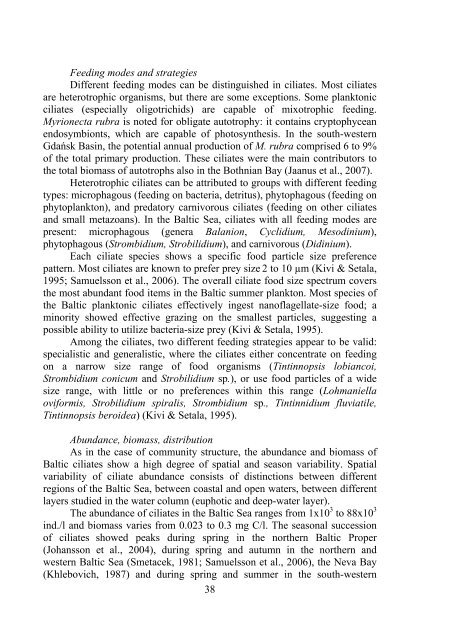Zooplankton of the open Baltic: Extended Atlas - IOW
Zooplankton of the open Baltic: Extended Atlas - IOW
Zooplankton of the open Baltic: Extended Atlas - IOW
Create successful ePaper yourself
Turn your PDF publications into a flip-book with our unique Google optimized e-Paper software.
Feeding modes and strategies<br />
Different feeding modes can be distinguished in ciliates. Most ciliates<br />
are heterotrophic organisms, but <strong>the</strong>re are some exceptions. Some planktonic<br />
ciliates (especially oligotrichids) are capable <strong>of</strong> mixotrophic feeding.<br />
Myrionecta rubra is noted for obligate autotrophy: it contains cryptophycean<br />
endosymbionts, which are capable <strong>of</strong> photosyn<strong>the</strong>sis. In <strong>the</strong> south-western<br />
Gdańsk Basin, <strong>the</strong> potential annual production <strong>of</strong> M. rubra comprised 6 to 9%<br />
<strong>of</strong> <strong>the</strong> total primary production. These ciliates were <strong>the</strong> main contributors to<br />
<strong>the</strong> total biomass <strong>of</strong> autotrophs also in <strong>the</strong> Bothnian Bay (Jaanus et al., 2007).<br />
Heterotrophic ciliates can be attributed to groups with different feeding<br />
types: microphagous (feeding on bacteria, detritus), phytophagous (feeding on<br />
phytoplankton), and predatory carnivorous ciliates (feeding on o<strong>the</strong>r ciliates<br />
and small metazoans). In <strong>the</strong> <strong>Baltic</strong> Sea, ciliates with all feeding modes are<br />
present: microphagous (genera Balanion, Cyclidium, Mesodinium),<br />
phytophagous (Strombidium, Strobilidium), and carnivorous (Didinium).<br />
Each ciliate species shows a specific food particle size preference<br />
pattern. Most ciliates are known to prefer prey size 2 to 10 µm (Kivi & Setala,<br />
1995; Samuelsson et al., 2006). The overall ciliate food size spectrum covers<br />
<strong>the</strong> most abundant food items in <strong>the</strong> <strong>Baltic</strong> summer plankton. Most species <strong>of</strong><br />
<strong>the</strong> <strong>Baltic</strong> planktonic ciliates effectively ingest nan<strong>of</strong>lagellate-size food; a<br />
minority showed effective grazing on <strong>the</strong> smallest particles, suggesting a<br />
possible ability to utilize bacteria-size prey (Kivi & Setala, 1995).<br />
Among <strong>the</strong> ciliates, two different feeding strategies appear to be valid:<br />
specialistic and generalistic, where <strong>the</strong> ciliates ei<strong>the</strong>r concentrate on feeding<br />
on a narrow size range <strong>of</strong> food organisms (Tintinnopsis lobiancoi,<br />
Strombidium conicum and Strobilidium sp.), or use food particles <strong>of</strong> a wide<br />
size range, with little or no preferences within this range (Lohmaniella<br />
oviformis, Strobilidium spiralis, Strombidium sp., Tintinnidium fluviatile,<br />
Tintinnopsis beroidea) (Kivi & Setala, 1995).<br />
Abundance, biomass, distribution<br />
As in <strong>the</strong> case <strong>of</strong> community structure, <strong>the</strong> abundance and biomass <strong>of</strong><br />
<strong>Baltic</strong> ciliates show a high degree <strong>of</strong> spatial and season variability. Spatial<br />
variability <strong>of</strong> ciliate abundance consists <strong>of</strong> distinctions between different<br />
regions <strong>of</strong> <strong>the</strong> <strong>Baltic</strong> Sea, between coastal and <strong>open</strong> waters, between different<br />
layers studied in <strong>the</strong> water column (euphotic and deep-water layer).<br />
The abundance <strong>of</strong> ciliates in <strong>the</strong> <strong>Baltic</strong> Sea ranges from 1x10 3 to 88x10 3<br />
ind./l and biomass varies from 0.023 to 0.3 mg C/l. The seasonal succession<br />
<strong>of</strong> ciliates showed peaks during spring in <strong>the</strong> nor<strong>the</strong>rn <strong>Baltic</strong> Proper<br />
(Johansson et al., 2004), during spring and autumn in <strong>the</strong> nor<strong>the</strong>rn and<br />
western <strong>Baltic</strong> Sea (Smetacek, 1981; Samuelsson et al., 2006), <strong>the</strong> Neva Bay<br />
(Khlebovich, 1987) and during spring and summer in <strong>the</strong> south-western<br />
38

















